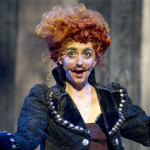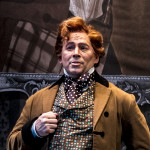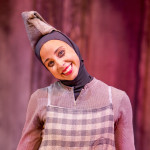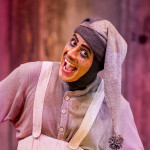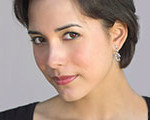Q&A: Shockheaded Peter
There is nothing really that compares to Shockheaded Peter. Our creative and design teams were tasked with building an entire production based on less than 30 pages of dialogue. Difficult? Yes. Challenging? For sure. Yet, everyone involved in this extraordinarily original and creative production has remarked that it has been one of the most rewarding experiences of their theatrical careers.
We asked them a few questions about the making of this wild and crazy ride.
What attracted you to the show? Choreographer Michael Mizerany!
It’s been described as vile, despicable, horrific, and absolute bliss. What words would you use to describe it? Scary, fantastic, thrilling, dark, smart.
What do you find most challenging and exciting about working on this production? Is there anything you can tell us about the creative process? Creating an entire show from 23 pages of text was such a wonderful experience. The rehearsal room was so open and encouraging. Learning how to clown was quite the experience!
What attracted you to the show? Rob Lutfy. I had never heard of the show and he spoke about it to me about a year ago. I listened to some of the soundtrack by the Tiger Lillies and it’s about the weirdest thing I’ve ever listened to. So of course I was fascinated! Being a weirdo myself, I looked forward to not only working on the show but working with and under Rob’s direction. It’s the kind of show that can be anything you want it to be. There is no structure. The script is a barely 30 pages and no written music for the band. So what you see here, you’ll never see again. This is all from the minds that have come together for this project here at Cygnet. It’s been an experience I’ve never had before. Pure collaboration and overwhelming generosity. I have learned so much from this entire process and couldn’t be more thankful.
It’s been described as vile, despicable, horrific, and absolute bliss. What words would you use to describe it? I think it is morbidly beautiful. It’s grotesquely awe inspiring. Human. There is a strange juxtaposition of beauty that comes from the horrible things that can happen in life.
What do you find most challenging and exciting about working on this production? Is there anything you can tell us about the creative process? It’s been such a generous group of people that I have felt nothing but support along the way. I am not the spectacular element of the show, but I am compelling it to happen. It’s also a character that is not something I typically play and yet there is still something within that I am finding I can identify with.
What attracted you to the show? The bizarre theatrical aspect.
It’s been described as vile, despicable, horrific, and absolute bliss. What words would you use to describe it? Frightening, playful, sadistic, unsettling, intriguing.
What do you find most challenging and exciting about working on this production? Is there anything you can tell us about the creative process? It can be difficult to remember all of the content we go through in a single rehearsal, but it’s a very welcomed challenge. Devising theatre is not easy, but it’s one of the most rewarding processes for an actor. To truly create your own track and show with a group of other professionals; absolute bliss. Plus it’s really scary, dark stuff that makes it all the more interesting to dive into.
What attracted you to the show? The creative team, the fact that it hasn’t been done in this area before, and the abstract story.
It’s been described as vile, despicable, horrific, and absolute bliss. What words would you use to describe it? Abstract, physical, heart-wrenching, dark, fun.
What do you find most challenging and exciting about working on this production? Is there anything you can tell us about the creative process? It’s pushing the limits and taking me out of my comfort zone, which is exciting and challenging. I am learning a lot and doing things I’ve never done or seen before on stage.
What attracted you to the show? Rob Lutfy. I love the way he works.
It’s been described as vile, despicable, horrific, and absolute bliss. What words would you use to describe it? I understand the adjectives previously used to describe the show, but I believe this production offers a new narrative and context for the horror. One might even see redemption and closure for the show’s main characters.
What do you find most challenging and exciting about working on this production? Is there anything you can tell us about the creative process? This is the kind of opportunity actors fear and relish simultaneously! It’s a chance to collaboratively create theatre. A high risk, high reward situation.
What attracted you to the show? I have never worked for Cygnet before, but always heard amazing things about it. I am fairly new to the musical theatre scene and have only done classical shows. This is the first time doing a show so far outside my comfort zone, and I can already tell how much I have learned and gained from doing it. It is an amazing opportunity to push our boundaries and be transported to a new world.
It’s been described as vile, despicable, horrific, and absolute bliss. What words would you use to describe it? Artistic, passionate, creepy, distorted, other worldly.
What do you find most challenging and exciting about working on this production? Is there anything you can tell us about the creative process? The most challenging aspect has been breaking my natural habits as a technical dancer to become the creature or character appropriate for the show. It has been about taking what is so ingrained in my body and manipulating it to something new, creative, and distorted. The creative process has been incredibly unique because we are creating something new and organic. From day one, Rob created a comfortable environment that made us feel safe to explore and play. This has been the most collaborative show I have ever done. It is our show, not just a show.
What attracted you to the show? I love all things horror/creature related and out of the norm.
It’s been described as vile, despicable, horrific, and absolute bliss. What words would you use to describe it? Creative, out of the norm, reality meets nightmares, and the “What if all the things your parents tried to scare you with really did happen?!” It’s a one of a kind masterpiece of how children who misbehave get punished. It brings you back to those myths you’d believe as a child.
What do you find most challenging and exciting about working on this production? Is there anything you can tell us about the creative process? Being part of the ensemble cast means I’ll be playing different characters, which, I love. But sometimes changes can occur in a flash, and I have to snap out of one character into the next in a matter of seconds.
What attracted you to the show? I was most attracted to the music, dark, and bizarre story. It also appealed to me because the script is so short, that I was intrigued as to how the cast along with the director and the production team were going to turn this into a full-fledged musical.
It’s been described as vile, despicable, horrific, and absolute bliss. What words would you use to describe it? Intriguing, bizarre, demonic, volatile, strange, scary, shocking, cruel, dark, grotesque, macabre, genius, fun, amusing.
What do you find most challenging and exciting about working on this production? Is there anything you can tell us about the creative process? The most challenging, yet exciting part about working on this production is the idea that the script is simply a road map for the show and that we are having to build a show from the ground up. I am not sure that I was initially prepared for the dark places that this show would take me, but by having the ability go to those dark places and transform, those are the times where I am able to find the humor in the show because the show is so extreme. I think that this show would push any performer out of their comfort zone because it is forcing each of us to step out of what we know as traditional theatre. It is hard to know in a show like this what is going to be too much, but we work together really well collectively, as an ensemble to ensure that we are telling the story the way that each of us wants to.
What attracted you to the show? Working with director Rob Lutfy.
It’s been described as vile, despicable, horrific, and absolute bliss. What words would you use to describe it? Your wildest nightmares made reality.
What do you find most challenging and exciting about working on this production? Is there anything you can tell us about the creative process? The most exciting thing is the collaborative, improvisational creative process. Rob excels at hiring exceptional people both cast and production team and then giving them the freedom to create. Through it all, Rob is always there to lend his expert opinion and guide the ship with his vision.
What attracted you to the show? The subversive nature of the text and songs but also working with Rob Lutfy again.
What do you find most challenging and exciting about working on this production? Working with a such wonderful creative team is the most exciting part.
What attracted you to the show? As a visual artist, designing Cygnet’s production of Shockheaded Peter is a quintessential project because seldom does the costume design play such a defining role for the entire production. Yes, costume always supports the individual character and production, however for me, since Shockheaded Peter is actually a picture book come to life, the picture becomes the focus and the words, or text, play the supporting role. You may be able to establish fear and influence the behavior of someone with words, but visually showing reasons for fearing is clearly more powerful.
It’s been described as vile, despicable, horrific, and absolute bliss. What words would you use to describe it? A visual thriller with a chilling aftertaste!
What do you find most challenging and exciting about working on this production? Even though the text for Shockheaded Peter is a mere 22 pages, the visual presentation requirements found within present large design challenges. The creative team has approached these challenges through the use of physical and visual theatre. There are so many images that have helped shape and frame the design language being used. Strongest influences for me have been: the picture book itself, German Expressionism, The Cabinet of Dr. Caligari, Tim Burton, Grand Guignol, and Comedia Del Arte. Collectively, the creative team is striving to bring the audience member into that dark imagination, incite a bizarre discomfort and alarm that would manifest as nervous laughter. And when they are asked in the show, “What is under your floorboards?” hopefully an almost audible shiver will be felt throughout the theatre.
Catch Shockheaded Peter through June 18th!
4 Key Influences of Shockheaded Peter
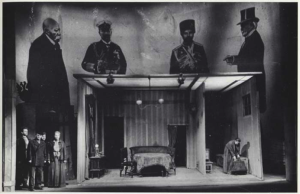
EPIC THEATRE was a theatrical movement that arose in the early to mid-20th century from the theories and method of a number of theatre practitioners (namely Bertolt Brecht) who responded to the political climate of the time through the creation of new political theatre. Epic theatre is often characterized by a series of loosely connected scenes that avoid illusion and often interrupt the storyline to address the audience directly with analysis, argument, or documentation. Brecht wanted his audiences to adopt a critical perspective in order to recognize social injustice and exploitation and be so moved as to effect change in the world outside the theatre walls. By highlighting the constructed nature of a theatrical event and employing various techniques used to remind the spectator that a play is a representation of reality, and not reality itself, Brecht hoped to communicate that the audience’s reality was equally constructed and, as such, was changeable.
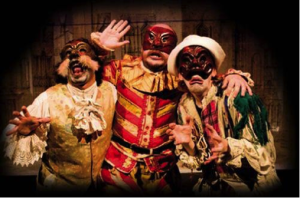 COMMEDIA DELL’ARTE is a theatrical form that emerged in northern Italy in the fifteenth century and rapidly gained popularity throughout Europe. It is characterized by improvised dialogue and a cast of colorful, masked stock characters. Performances were based on a set schema, or scenario—a basic plot, often a familiar story, upon which the actors improvised their dialogue, leaving actors to tailor a performance to their audience, allowing for sly commentary on current politics and bawdy humor that would otherwise be censored. The characters of the commedia usually represent fixed social archetypes, or stock characters, such as enamored lovers, foolish old men, devious servants, or military officers full of false bravado. And each stock character of the commedia evolved a distinct set of attributes—characteristic speech, gestures, props, and costume—that became standard to the portrayal of the character. All characters except for the lovers and the comic servant wore masks, a tradition deriving from ancient Roman comedies that featured similar character types. Because the mask partially or entirely obscured facial expression, emphasis was placed on dialect (often reflecting regional stereotypes) and exaggerated gesture to convey emotion and intention.
COMMEDIA DELL’ARTE is a theatrical form that emerged in northern Italy in the fifteenth century and rapidly gained popularity throughout Europe. It is characterized by improvised dialogue and a cast of colorful, masked stock characters. Performances were based on a set schema, or scenario—a basic plot, often a familiar story, upon which the actors improvised their dialogue, leaving actors to tailor a performance to their audience, allowing for sly commentary on current politics and bawdy humor that would otherwise be censored. The characters of the commedia usually represent fixed social archetypes, or stock characters, such as enamored lovers, foolish old men, devious servants, or military officers full of false bravado. And each stock character of the commedia evolved a distinct set of attributes—characteristic speech, gestures, props, and costume—that became standard to the portrayal of the character. All characters except for the lovers and the comic servant wore masks, a tradition deriving from ancient Roman comedies that featured similar character types. Because the mask partially or entirely obscured facial expression, emphasis was placed on dialect (often reflecting regional stereotypes) and exaggerated gesture to convey emotion and intention.
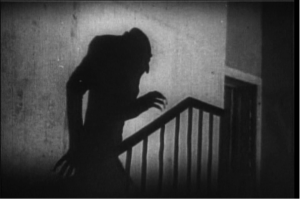
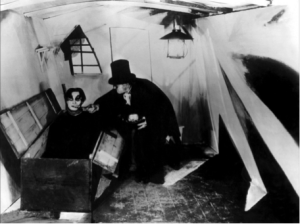
GERMAN EXPRESSIONISM refers to a series of related creative movements beginning in Germany before World War I that reached a peak in Berlin during the 1920s. As part of the larger Expressionist movement in North and Central Europe in fields such as architecture, dance, painting, sculpture and cinema, it emphasized directness, frankness, and a desire to startle the viewer. German cinema in particular had a major influence on American films, particularly in the genres of horror and film noir. The Cabinet of Dr. Caligari, a 1920 German silent horror film directed by Robert Wiene and written by Hans Janowitz and Carl Mayer, is considered by many to be the quintessential work of German Expressionist cinema.
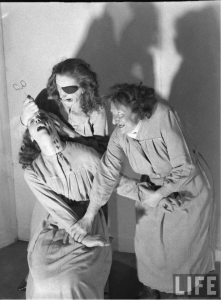
THE GRAND GUIGNOL (1897-1962) was a theatre in the Pigalle area of Paris that specialized in naturalistic horror shows. Its name is often used as a general term for graphic amoral horror entertainment, a genre popular from Elizabethan and Jacobean theatre through today’s splatter films. Their popular and well-known horror plays featured a distinctly bleak worldview, as well as notably gory special effects in their notoriously bloody climaxes.
Fall into the world of Victorian steam-punk nightmares as a manic music box spins stories of naughty children and misguided parents. Silly and sinister, Shockheaded Peter dares us to ask what’s beneath the floorboards.
Don’t miss the most damning tale ever told on stage! Runs through June 18th.
Season 14 Announced!
From classic musicals to shocking contemporary works, Season 2016-17 promises to be a true “Cygnet” Season
Every season must reflect the mission of the company and for the past 13 years, Artistic Director Sean Murray has crafted uniquely Cygnet seasons that reflect the commitment to “startle the soul, embrace diversity and ignite debate.” This year is no exception. The seven productions in Season 14 range from the traditional to the avant- garde and include two musical theatre classics, a two-show repertory by a Pulitzer prize-winning playwright, the return of a holiday favorite and two contemporary works sure to shock and amaze.
“I’m really proud of the diversity and quality of this season,” says Murray. “Leave it to us to go from a stripper, to an ex-con, to one naughty little boy in just one season. That’s exciting. That’s Cygnet!”
SEASON XIV: 2016-2017
List of Plays
GYPSY
July 14th – Sept 4th
Music by Jule Styne and Lyrics by Stephen Sondheim
Book by Arthur Laurents
Directed by Sean Murray
Choreography by David Brannen
Music Direction by Terry O’Donnell
Indomitable stage mother Rose chases vicarious success and stardom as she pushes her daughters through the vaudeville circuit. When Dainty June flees the act to elope, Rose vows to make introverted Louise into a star. Boasting one show-stopping song after another—like “Everything’s Coming Up Roses” and “Let Me Entertain You”—this classic musical was inspired by the memoirs of the legendary burlesque dancer Gypsy Rose Lee. Featuring Linda Libby as Mama Rose, Allison Spratt Pearce as Louise, Katie Whalley-Banville as Dainty June, and Manny Fernandes as Herbie.
“The quintessential American musical” – Hollywood Reporter

Repertory
SEVEN GUITARS
Sept 28th – Nov 6th
By August Wilson
San Diego Premiere
In the backyard of a Pittsburgh tenement in 1948, friends gather to mourn for a blues guitarist and singer who died just as his career was on the verge of taking off. The action that follows is a flashback to the busy week leading up to Floyd’s sudden and unnatural death. Seven Guitars is part bawdy comedy, part dark elegy and part mystery. This lyrical play is the sixth in August Wilson’s ten-play cycle which charts the African-American experience through each decade of the 20th century and is performed in rep with King Hedley II.
“Rich, music-drenched drama” – New York Times
Repertory
KING HEDLEY II
Sep. 29th – Nov. 6th
By August Wilson
San Diego Premiere
King Hedley II shares the story of King –a man recently released from prison, attempting to rebuild his life amid changing times and a backdrop of the crime and drug struggles in the community he exists in. King dreams of a life of stability and self-reliance beyond incarceration, gangs and broken family. The play dares to ask what it takes to transcend the limitations of life and personal circumstance, and if pure will is enough to change a man’s destiny. King Hedley II is the eighth play in August Wilson’s ten-play cycle that, decade by decade, examines African American life in the United States during the twentieth century.
“Mesmerizing…. Full of powerful images that convey the darkly comic dialogue between hope and hopelessness in African American life.” – N.Y. Daily News
A CHRISTMAS CAROL
Nov 22nd – Dec 24th
Adaptation & Lyrics by Sean Murray
Original Score by Billy Thompson
Directed by Sean Murray
Musical Direction by Patrick Marion
Cygnet Theatre invites you to start your own family tradition with one of ours. This season welcomes the return of the holiday classic adapted from Charles Dickens’ timeless tale of hope and redemption. This re-imagined, fully staged production features original new music, creative stagecraft and puppetry, and live sound effects. Step into a Victorian Christmas card for a unique storytelling experience that is sure to delight the entire family!
“Critics Pick” in 2014 – San Diego Union Tribune
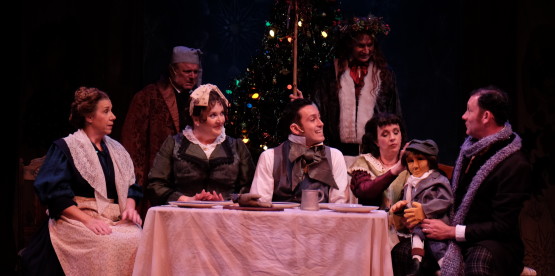
BAD JEWS
Jan 12th – Feb 12th
By Joshua Harmon
Directed by Rob Lutfy
San Diego Premiere
The night after their grandfather’s funeral, three cousins engage in a verbal battle royale over a family heirloom. In one corner is the unstoppable and self-assured force of “Super Jew” Daphna. In the other, the immovable and entitled object of her secular cousin Liam. And in the middle is Liam’s brother Jonah, trying to stay out of the fray. Bad Jews is a savage comedy about family, faith, and legacy.
“The funniest play of the year.”-The Washington Post
“Delectably savage humor” – The New York Times
ON THE 20TH CENTURY
March 9th – April 30th
San Diego Premiere
Book and Lyrics by Betty Comden and Adolph Green
Music by Cy Coleman
Directed by Sean Murray
Its nonstop laughs aboard the Twentieth Century, a luxury train traveling from Chicago to New York City. Luck, love and mischief collide when the bankrupt theater producer Oscar Jaffee embarks on a madcap mission to cajole glamorous Hollywood starlet Lily Garland into playing the lead in his new, non-existent epic drama. But is the train ride long enough to reignite the spark between these former lovers, create a play from scratch, and find the money to get it all the way to Broadway? Featuring Eileen Bowman as Lily Garland and Melinda Gilb as Letitia Primrose.
“Old-fashioned musical comedy magic”– USA Today
“The show is a nonstop delight.” – The New York Post

SHOCKHEADED PETER
May 18th – June 18th
West Coast Regional Premiere
Music by Adrian Huge, Martyn Jacques, Adrian Stout
Lyrics by Martyn Jacques
Book by Julian Bleach, Anthony Cairns, Graeme Gilmour, Tamzin Griffen
Based on Struwwelpeter by Heinrich Hoffmann
Directed by Rob Lutfy
Fall into the world of Victorian Steam-punk nightmares as a manic music-box spins stories of naughty children and misguided parents. Silly and sinister, Shockheaded Peter dares us to ask what’s beneath the floorboards. Don’t miss the most damning tale ever told on stage!
“A vile and repulsive story told by reprehensible characters in a thoroughly degenerate fashion – Absolute Bliss” – David Bowie
“A wryly seedy cabaret-punk musical” -Variety
Come join us for this wild ride! Tickets and new subscriptions will be available for purchase on March 1st.

